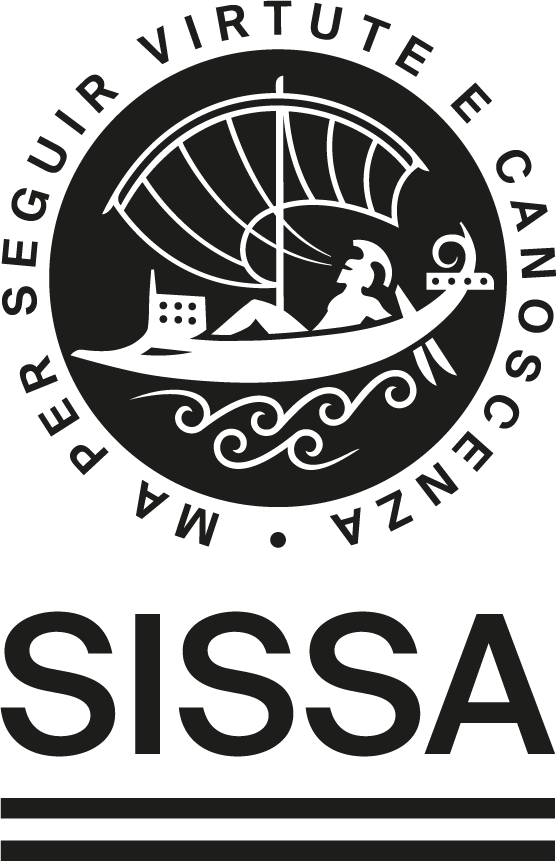When: Thursday, 21st February, 2019
Where: ICTP, Adriatico Guest House, Kastler lecture hall
| 10:00–10:30 | Welcome coffe and discussions | |
|---|---|---|
| 10:30–11:05 | Paola Ruggiero | |
| Conformal Field Theory for Inhomogeneous Systems: the Example of a Breathing Tonks-Girardeau gas | ||
| 11:05–11:40 | Adriano Angelone | |
| Glass and Superglass phases of unfrustrated bosons | ||
| 11:40–12:15 | Pavel Kos | |
| Solving Chaotic Quantum Many-body Systems: Entanglement Entropy | ||
| 12:15–13:15 | Lunch | |
| 13:15–15:15 | Discussions | |
| 15:15–15:50 | Gonzalo Manzano Paule | |
| Thermodynamics and Entropy Production along Quantum Trajectories | ||
| 15:50–16:25 | Bojan Žunkovič | |
| Dynamical phase transitions: exact solutions/Stochastic tensor networks | ||
| 16:25–17:00 | Paolo Mazza | |
| Slow dynamics in constrained many body quantum systems | ||
Speaker: Paola Ruggiero
Abstract: Conformal field theory (CFT) has been extremely successful at describing universal effects in critical one-dimensional (1D) systems, in situations in which the bulk is uniform. However, in many experimental contexts, such as quantum gases in trapping potentials and in several out-of-equilibrium situations, systems are strongly inhomogeneous. Recently it has been shown that the CFT methods can be extended to deal with such 1D situations [1,2]: the system’s
inhomogeneity gets reabsorbed in the parameters of the theory, such as the metric, resulting in a CFT in curved space. In this talk, I show that it is possible to extend the same ideas to the out-of-equilibrium situation generated by a frequency quench in a Tonks-Girardeau gas in a harmonic trap [3]. I show compatibility with known exact result and use this new method to compute new quantities, not explicitly known by means of other methods, such as the dynamical fermionic propagator and the n-particle density matrix at different times.
References:
[1] J. Dubail, JM. Stéphan, J. Viti, P. Calabrese, SciPost Phys. 2, 002 (2017).
[2] S. Murciano, P. Ruggiero, P. Calabrese, arXiv:1810.02287
[3] P. Ruggiero, Y. Brun, J. Dubail, arXiv:1901.08132.
Speaker: Adriano Angelone
External sources of disorder in many-body systems are a commonplace way to generate frustration, which in turn may lead to the appearance of glassy phases (i.e., localized but disordered states). In my talk, I will discuss my results for a system of monodisperse hardcore lattice bosons with finite-range interactions, of interest for experiments with Rydberg-dressed atoms. Here, out-of-equilibrium glassy behavior is observed without the ad-hoc addition of frustration; the latter is provided by the self-induced formation of particle clusters, which induce an effective polidispersity in the system. For intermediate interaction strength, glassy behavior is also found to coexist with superfluidity, in the out-of-equilibrium counterpart of a supersolid state known as a ‘superglass’.
Speaker: Pavel Kos
When discussing solvable models, we usually think about free and integrable models. These models have many special properties, which are different from chaotic models. In this talk, I will discuss an exact solution of the entanglement entropy dynamics of a chaotic many-body system. In particular, I will demonstrate how, using a special property of a duality point of the kicked Ising spin chain, we managed to compute the time evolution of the entanglement entropy for a set of initial states. The dynamics of the entanglement entropy indicates that the information spreads with a maximal speed and that the entanglement saturates to the maximum value. The result holds for a clean or disordered system without any scaling limit.
References:
B. Bertini, P. Kos, and T. Prosen, arXiv:1812.05090
B. Bertini, P. Kos, and T. Prosen, Phys. Rev. Lett. 121, 264101(2018)
Speaker: Gonzalo Manzano Paule
Abstract: In this talk I will introduce some notions in quantum thermodynamics when monitoring of the environment is available. More precisely I will focus on the formalism of CPTP maps and quantum jump trajectories. I will discuss entropy production in this context and show that different fluctuation relations can be obtained in very general setups. Finally I will succinctly present some recent results regarding a different and more general set of universal relations holding for systems in nonequilibrium steady states.
Speaker: Bojan Žunkovič
Abstract:I will describe two problems. First, I will discuss statistical and dynamical properties of the XY model with a self-consistent transverse field and show some exact results. Then, I will present a stochastic matrix product state (MPS) method that interpolates between the standard phase-space methods and variational MPS methods.
Speaker: Paolo Mazza
A recent experiment performed in a 51-Rydberg atoms chain with nearest neighbours strong interactions (“blockade regime”), observed long-lived oscillations in the expectation value of local observables quenching from a Neel-ordered initial state. This fact seems to violate the common belief according to which the initial state should have rapidly thermalized. Although successive works shaded some light on the phenomenon, a complete theoretical understanding is still lacking.
In this talk I will present a new approach to tackle this problem, connecting it to epitome phenomena in high-energy physics. In particular, I will show how the Hamiltonian describing the atom chain can be exactly mapped to a U(1) lattice gauge theory, namely S=1/2-QLM. This fact enables us to interpret the observed long-lived oscillations as slow “string” dynamics and, furthermore, shows the possibility of performing large scale quantum simulations in lattice gauge theories with the state-of-the-art technology.

